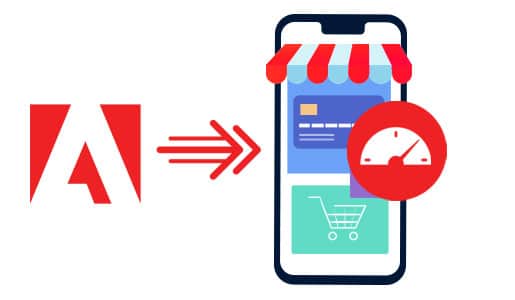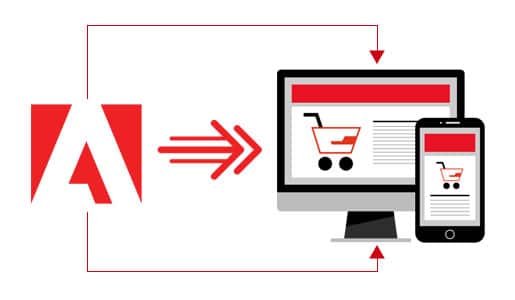
How does a 1-second delay in page load time impact conversions in eCommerce? How crucial is Adobe Commerce speed optimization, specifically for mobile devices, for the success of an online store? In this blog, we will explore the significance of mobile page speed and discuss practical strategies to optimize an Adobe Commerce site for enhanced mobile page speed and responsiveness.
Join us on this journey to deliver a faster and smoother shopping experience for mobile users.
Importance of Mobile Page Speed

How important is mobile page speed and responsiveness for eCommerce stores, particularly those using Adobe Commerce? In the smartphone era, these factors have become critical. With some Adobe Commerce speed optimization techniques, you can significantly enhance the user experience, leading to higher engagement and conversions.
According to Google, 53% of mobile site visits are abandoned if pages take longer than 3 seconds to load. This statistic underscores the importance of optimizing your Adobe Commerce site for mobile page speed and responsiveness.
By doing Adobe Commerce speed optimization correctly, you can ensure that your customers have a smooth and enjoyable shopping experience, regardless of the device they’re using.
Understanding Mobile Page Speed
Mobile page speed can make or break your eCommerce store’s success. Basically, mobile page speed refers to how quickly your site loads on a mobile device.
Along with mobile page speed, site responsiveness is also important. Responsiveness refers to how well your site adapts to different screen sizes. Hence, both factors are crucial for SEO (Search Engine Optimization) and user experience.
Google uses mobile page speed as a ranking factor, meaning faster sites are more likely to appear at the top of search results.
Additionally, a responsive site ensures that users have a positive experience, regardless of whether they’re using a smartphone, tablet, or desktop computer.
According to a study by Akamai, a 100-millisecond delay in website load time can hurt conversion rates by 7 percent. (Source: Markettailor) This highlights the importance of optimizing your Adobe Commerce site for mobile page speed and responsiveness. This is where Adobe Commerce speed optimization comes into the picture.
The Impact of Speed on User Experience & Conversion
Wondering how the speed of a website impacts user experience and conversions.
Imagine this: a user lands on your site, excited to browse through your products, but the pages take forever to load. Frustrated, they abandon your store and head over to a competitor’s site. Sounds like a nightmare, right?
Well, research suggests that even a one-second delay in page load time can result in a 7% decrease in conversions.
So, what’s the solution? Optimizing your Adobe Commerce store for speed.
Well, by opting for Adobe Commerce speed optimization, you can significantly improve user experience, increase customer satisfaction, and give your sales a nice little boost.
Server & Hosting
Now, let’s talk about servers and hosting. Choosing the correct server and hosting environment is the first critical step during the Adobe Commerce speed optimization process for an eCommerce store.
Remember, your hosting provider should be like a reliable partner, offering steady performance, fast response times, and the ability to scale your business.
And here’s a tip: selecting an Adobe Commerce server that’s geographically close to your target audience can significantly reduce latency and improve your website’s load times.
This, in turn, can improve your Adobe Commerce store’s speed. When a site loads fast, it can lead to improved conversion.
So, if you’re serious about speed, it’s time to get strategic about Adobe Commerce speed optimization services.
Current Industry Benchmarks for Mobile Page Speed
In order to ensure optimal mobile page speed, it is crucial to understand where your website stands in comparison to industry benchmarks. Currently, the industry standard for mobile page speed is set at less than 3 seconds. This implies that your website should ideally load in under 3 seconds on a mobile device.
Therefore, meeting or surpassing this benchmark is of utmost importance as it directly affects user retention and conversion rates.
Furthermore, faster-loading websites have a higher likelihood of ranking higher in search results, resulting in increased visibility and traffic. In a highly competitive digital landscape where every second matters, optimizing your Adobe Commerce site for mobile page speed can provide you with a significant advantage.
How to Measure Your Adobe Commerce Site’s Mobile Page Speed?
In order to effectively enhance the mobile page speed of your Adobe Commerce site, it is imperative to assess your current standing.
To accomplish this, there are numerous tools and techniques available for measuring mobile page speed. Some widely used tools include Google’s PageSpeed Insights, GTmetrix, and Pingdom.
These tools offer a comprehensive range of information, such as an overall speed score for your site, detailed breakdowns highlighting areas that require improvement, and optimization suggestions.
Accurately interpreting these results is crucial for understanding how to enhance your site’s performance. For example, a low-speed score indicates that your site is slower than the average and necessitates optimization.
Conversely, a high score suggests that your site is performing well. However, even high-performing sites can often benefit from further optimization.
According to Google, a good page speed score is above 90, so it is advisable to aim for this score as your benchmark.
Steps to Optimize Your Adobe Commerce Site for Improved Mobile Page Speed
Optimizing an Adobe Commerce site for improved mobile page speed involves several steps. Let’s dive into each one.
Identifying Pages with Excessive Round Trip Requests (RTRs)
RTRs occur when a browser makes multiple requests to a server to load a page. This can slow down your site’s load time. Using tools like Google’s PageSpeed Insights, you can identify pages with excessive RTRs and take steps to reduce them.
Combining Files Where Possible
Each HTTP request a browser makes to a server takes time. By combining CSS and JavaScript files, you can reduce the number of HTTP requests, leading to faster page loads
Optimizing the Order of Rendering
Users perceive a site as faster if the above-the-fold content loads quickly. By optimizing the order of rendering to load this content first, you can improve user experience.
Creating a Page Load Strategy
This involves deciding which elements to load first and which to defer until later. Not all elements of a page need to load immediately. By creating a page load strategy, you can decide which elements to load first and which to defer until later.
Compressing Everything That You Can
Compression is a technique that reduces the size of your site’s files, leading to faster load times. This can involve techniques like minifying CSS and JavaScript files and compressing images. Minification removes unnecessary characters from code without changing its functionality, while image compression reduces the file size of images without significantly affecting their quality. Adobe Commerce has built-in features for minification, and there are also extensions available for image compression.
Caching the Right Pages at the Right Time
Caching is a technique that involves storing copies of your site’s pages and serving them to users, which can significantly improve page load speed. When a user visits a cached page, the stored copy is served, which is faster than loading the page from the server. Adobe Commerce has built-in caching features, and there are also extensions available for more advanced caching strategies.
Building Accelerated Mobile Pages (AMPs)
AMPs are a Google-backed project designed to make mobile pages load faster. They are lightweight versions of standard web pages that load quickly on mobile devices. By implementing AMPs, you can significantly improve your mobile page speed. There are extensions available for Adobe Commerce that can help you implement AMPs.
By implementing these techniques, you can optimize your Adobe Commerce site for improved mobile page speed and provide a better user experience.
Making Your Adobe Commerce Site Responsive

In today’s digital era, it is imperative for websites, especially Adobe Commerce sites that support eCommerce businesses, to be responsive. This means that the website should adapt and function effectively on various devices, including desktops and smartphones.
This is crucial since an increasing number of people are using mobile devices for online shopping.
To ensure your Adobe Commerce site is responsive, there are several steps you can follow.
Select a Responsive Theme
Adobe Commerce offers a variety of themes that are designed to be responsive. Choosing one of these themes is the first step towards making your site mobile-friendly.
Optimize Your Images
Large images can slow down your site, particularly on mobile devices. Use an image optimizer tool to reduce the file size of your images without compromising on quality.
Incorporate Mobile-Friendly Plugins
There are numerous Adobe Commerce plugins available that can enhance the mobile user experience. These plugins can help improve the layout, load time, and functionality of your site on mobile devices.
Test Your Site
Lastly, it is crucial to test your site’s performance on mobile devices. Utilize tools like Google’s Mobile-Friendly Test to assess your site’s responsiveness and identify areas that require improvement.
By following these steps, you can ensure that your Adobe Commerce site provides a seamless shopping experience, regardless of the device your customers are using.
Case Study Adobe Commerce Speed Optimization
Let’s delve into a real-life example of an Adobe Commerce site that significantly improved its mobile page speed and responsiveness. Thanks to Adobe Commerce speed optimization.
The company in question is Café du Cycliste, a renowned provider of high-quality technical cyclists’ apparel.
Café du Cycliste’s Challenge
Café du Cycliste realized that their website wasn’t performing optimally, especially when compared to its competitors. Their Google PageSpeed Insights scores were low for both mobile and desktop versions of their site. They knew that optimization solutions could deliver their text and image content to customers faster and more efficiently.
Results Achieved
After the Adobe Commerce speed optimization process, there were significant boosts in speed scores on both mobile and desktop. The Google PageSpeed Insight Score for the home page increased for mobile and desktop.
(Source: BSSCommerce)
So, from this case study, it’s clear that a strategic and comprehensive approach to Adobe Commerce site optimization can lead to significant improvements in mobile page speed and responsiveness.
By implementing similar strategies, you too can enhance your Adobe Commerce site’s performance and deliver a better user experience.
Conclusion
In conclusion, it is crucial to optimize your Adobe Commerce site for improved mobile page speed and responsiveness. You can greatly enhance your site’s speed, performance, and user experience with the help of Adobe Commerce speed optimization services.
If you are seeking professional assistance with Adobe Commerce speed optimization, Wagento is available to provide support. With a team of experts and a proven record of accomplishment, we can help you achieve your business goals.
So, whether you need help with Adobe Commerce performance optimization or ERP (Enterprise Resource Planning) integration services, we can help you out. Just give us a call now!
Are you prepared to take the next step? Visit Wagento’s site to fulfill all your Adobe Commerce speed optimization requirements and more. In fact, our professionals can help you out with platform upgrades, website migration, eCommerce website development, website audit, and any other needs.
Let’s collaborate to develop a faster and more responsive Adobe Commerce site for the success of your business.













